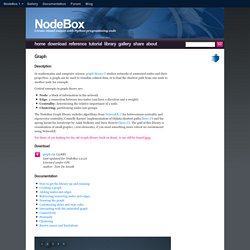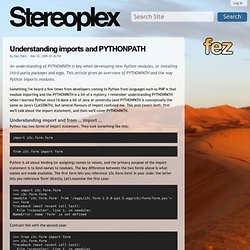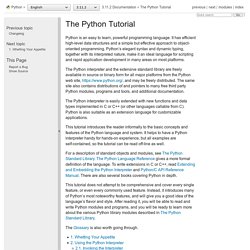Python
> Skac
The Glowing Python. PyPy - Welcome to PyPy. Graph. Graph Description In mathematics and computer science, graph theory studies networks of connected nodes and their properties.

A graph can be used to visualize related data, or to find the shortest path from one node to another node for example. Central concepts in graph theory are: Node: a block of information in the network.Edge: a connection between two nodes (can have a direction and a weight).Centrality: determining the relative importance of a node.Clustering: partitioning nodes into groups. The NodeBox Graph library includes algorithms from NetworkX for betweenness centrality and eigenvector centrality, Connelly Barnes' implementation of Dijksta shortest paths (here) and the spring layout for JavaScript by Aslak Hellesoy and Dave Hoover (here).
For those of you looking for the old Graph library built on Boost, it can still be found here. Download Documentation The library has a cool example of a visual browser for WordNet. How to get the library up and running. Spyderlib - Spyder is the Scientific PYthon Development EnviRonment. WinPython. Welcome to graph-tool’s documentation! — graph-tool 2.2.29.1 documentation. Overview of Bulbs, a Python Framework for Graph Databases like Neo4j. A Python framework for graph databases. Bulbs is an open-source Python persistence framework for graph databases and the first piece of a larger Web-development toolkit that will be released in the upcoming weeks. It’s like an ORM for graphs, but instead of SQL, you use the graph-traveral language Gremlin to query the database. Bulbs supports pluggable backends, and you can use it to connect to either Neo4j Server or Rexster.
Neo4j Server is Neo4j‘s official server. Rexster is TinkerPop‘s server, and it supports any Blueprints-enabled database, including Neo4j, OrientDB, Dex, and OpenRDF. This means your code is portable because you can to plug into different graph database backends without worrying about vendor lock in. Bulbs was developed in the process of building Whybase, a startup that will open for preview later this year. You can use Bulbs from within any Python Web-development framework, including Flask, Pyramid, and Django. Code Example Here’s how you model domain objects: Why Graphs?
Understanding imports and PYTHONPATH — Stereoplex. Something I've heard a few times from developers coming to Python from languages such as PHP is that module importing and the PYTHONPATH is a bit of a mystery.

I remember understanding PYTHONPATH when I learned Python since I'd done a bit of Java at university (and PYTHONPATH is conceptually the same as Java's CLASSPATH), but several flavours of import confused me. This post covers both; first we'll talk about the import statement, and then we'll cover PYTHONPATH. Understanding import and from ... import ...
Python has two forms of import statement. They look something like this: import z3c.form.form from z3c.form import form Python is all about binding (or assigning) names to values, and the primary purpose of the import statement is to bind names to modules.
Orange – Data Mining Fruitful & Fun. SciPy -
Python plotting — Matplotlib 1.2.0 documentation. Machine learning in Python — scikit-learn 0.13 documentation.
Jython
The Python Tutorial. Python is an easy to learn, powerful programming language.

It has efficient high-level data structures and a simple but effective approach to object-oriented programming. Python’s elegant syntax and dynamic typing, together with its interpreted nature, make it an ideal language for scripting and rapid application development in many areas on most platforms. The Python interpreter and the extensive standard library are freely available in source or binary form for all major platforms from the Python Web site, and may be freely distributed.
The same site also contains distributions of and pointers to many free third party Python modules, programs and tools, and additional documentation. The Python interpreter is easily extended with new functions and data types implemented in C or C++ (or other languages callable from C). This tutorial introduces the reader informally to the basic concepts and features of the Python language and system.
The Glossary is also worth going through.
The Python Tutorial — Python v3.3.0 documentation. Python is an easy to learn, powerful programming language.

It has efficient high-level data structures and a simple but effective approach to object-oriented programming. Python’s elegant syntax and dynamic typing, together with its interpreted nature, make it an ideal language for scripting and rapid application development in many areas on most platforms. The Python interpreter and the extensive standard library are freely available in source or binary form for all major platforms from the Python web site, and may be freely distributed. The same site also contains distributions of and pointers to many free third party Python modules, programs and tools, and additional documentation.
The Python interpreter is easily extended with new functions and data types implemented in C or C++ (or other languages callable from C). This tutorial introduces the reader informally to the basic concepts and features of the Python language and system. The Glossary is also worth going through.
Python Programming Language – Official Website. PyDev. Python (programming language)
PyBrain.
Django




